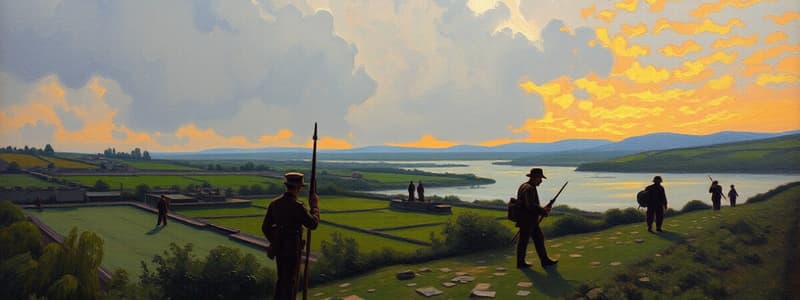Podcast
Questions and Answers
What were the main countries involved in the Triple Entente?
What were the main countries involved in the Triple Entente?
- Germany
- Russia (correct)
- France (correct)
- Great Britain (correct)
What event started World War I?
What event started World War I?
Assassination of Archduke Ferdinand
What is the definition of neutrality?
What is the definition of neutrality?
A position of not taking sides in a conflict
What was the name originally given to the First World War?
What was the name originally given to the First World War?
What was the Lusitania?
What was the Lusitania?
The causes of the Great War include: militarism, alliances, _____, and nationalism.
The causes of the Great War include: militarism, alliances, _____, and nationalism.
What were the causes of U.S. entry into World War I?
What were the causes of U.S. entry into World War I?
What is trench warfare?
What is trench warfare?
What was the purpose of the Zimmerman Telegram?
What was the purpose of the Zimmerman Telegram?
What did the draft / Selective Service Act require?
What did the draft / Selective Service Act require?
What does nativism refer to?
What does nativism refer to?
What was the American Protective League known for?
What was the American Protective League known for?
What was the purpose of the Committee on Public Information?
What was the purpose of the Committee on Public Information?
What did the Espionage & Sedition Acts do?
What did the Espionage & Sedition Acts do?
What are war bonds?
What are war bonds?
What were the 14 Points?
What were the 14 Points?
What was the Influenza Pandemic of 1918-1919?
What was the Influenza Pandemic of 1918-1919?
What was the League of Nations?
What was the League of Nations?
What was the Treaty of Versailles known for?
What was the Treaty of Versailles known for?
What is the Red Scare?
What is the Red Scare?
What was the Red Summer of 1919?
What was the Red Summer of 1919?
What is the Great Migration?
What is the Great Migration?
What were the strikes of 1919 about?
What were the strikes of 1919 about?
What caused the race riots of 1919?
What caused the race riots of 1919?
Flashcards are hidden until you start studying
Study Notes
World War I and Its Causes
- Triple Entente: A military alliance formed by Great Britain, France, and Russia before World War I.
- Assassination of Archduke Ferdinand: The event that triggered WWI, carried out by a Serbian nationalist.
- Causes of the Great War: Key factors include militarism, alliances, imperialism, and nationalism.
U.S. Involvement in the War
- Causes of U.S. Entry:
- Sinking of the Lusitania in 1915 killed 139 Americans, leading to pressure on Germany to cease submarine warfare.
- The Zimmerman Telegram urged Mexico to attack the U.S. in exchange for German support, further escalating tensions.
Warfare Tactics
- Trench Warfare: Combat method where opposing armies occupy fortified trenches, leading to a stagnant front and high casualties.
- Submarine Warfare: Primarily involved German U-Boats targeting Atlantic supply convoys to Britain.
Domestic Reactions and Policies
- Draft / Selective Service Act: Mandated registration of men for potential military service, facilitating troop mobilization.
- Nativism and "Hyphenated Americans": Preference for native-born citizens over immigrants, leading to societal tensions.
- American Protective League: Nativist organization that targeted perceived "disloyals" during the war effort.
Information Control
- Committee on Public Information: Government body created to disseminate propaganda, fostering public support for the war.
- Espionage & Sedition Acts: Laws restricting dissent and false statements about the war, affirmed by the Supreme Court in Schenk v. United States.
Financial Aspects of War
- War Bonds / Liberty Bonds: Certificates sold by the government to finance military operations during WWI.
Post-War Impact and Agreements
- 14 Points: Proposed by President Wilson, outlined a framework for peace and formation of the League of Nations post-WWI.
- Influenza Pandemic (1918-1919): A deadly outbreak claiming over 20 million lives globally, exacerbating post-war challenges.
International Relations
- League of Nations: Established in 1920 to foster international cooperation and maintain peace.
- Treaty of Versailles: Notorious for imposing heavy reparations on Germany following WWI, reshaping European borders and politics.
Social Unrest in the U.S.
- Red Scare: Period marked by widespread fear of communism and threats to American ideals.
- Red Summer (1919): Nationwide racial tensions leading to violence in multiple cities, driven by demands for equality and resistance to change.
- Great Migration: Movement of African Americans from the rural South to industrial North seeking jobs and better living conditions.
- Strikes of 1919: Women's movements for political rights highlighted broader social issues in the aftermath of the war.
- Race Riots of 1919: Resulted from racial discord and economic disparities, leading to significant violence and destruction across various American cities.
Studying That Suits You
Use AI to generate personalized quizzes and flashcards to suit your learning preferences.




